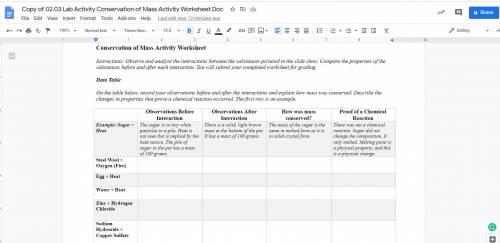
Chemistry, 21.10.2020 19:01 criser1987zach
Conservation of Mass Activity Worksheet
Instructions: Observe and analyze the interactions between the substances pictured in the slide show. Compare the properties of the substances before and after each interaction. You will submit your completed worksheet for grading.
Data Table
On the table below, record your observations before and after the interactions and explain how mass was conserved. Describe the changes in properties that prove a chemical reaction occurred. The first row is an example.
Observations Before Interaction
Observations After Interaction
How was mass conserved?
Proof of a Chemical Reaction
Example: Sugar + Heat:
Observations Before Interaction
The sugar is in tiny white particles in a pile. Heat is not seen but is implied by the heat source. The pile of sugar in the pot has a mass of 100 grams.
Observations After Interaction
There is a solid, light brown mass at the bottom of the pot. It has a mass of 100 grams.
How was mass conserved?
The mass of the sugar is the same in melted form as it is in solid crystal form.
Proof of a Chemical Reaction
There was not a chemical reaction. Sugar did not change the composition. It only melted. Melting point is a physical property, and this is a physical change.
Do This For
Steel Wool + Oxygen (Fire)
Egg + Heat
Water + Heat
Zinc + Hydrogen Chloride
Sodium Hydroxide + Copper Sulfate


Answers: 1
Another question on Chemistry

Chemistry, 21.06.2019 13:10
How many grams of naoh are needed to make 0.250 liter of a 0.500 m solution of naoh? 0.125 g 5.00 g 2.00 g
Answers: 1

Chemistry, 21.06.2019 17:10
There are 6.022 x 10^23 atoms of hg in 1 mole of hg. the number of atoms in 4.5 moles of hg can be found by multiplying 4.5 by 6.022 x 10^23 a. 2.7 x 10^24 b. 27 x 10^23 c. 2.71 x10^24 d. 27.099 x 10^23
Answers: 3

Chemistry, 21.06.2019 22:30
1. combine iron and copper (ii) sulfate solution. (hint: iron will form the iron (iii) ion) fe + cuso4 → 2. combine lead (ii) nitrate and potassium iodide solutions. pb(no3)2+ kl → 3. combine magnesium metal and hydrochloric acid solution. mg + hcl → 4. electrolysis (splitting) of water. h2o → 5. burning magnesium. mg + o2 →
Answers: 3

Chemistry, 22.06.2019 03:50
Express the following number in scientific notation. 0.026890 =
Answers: 1
You know the right answer?
Conservation of Mass Activity Worksheet
Instructions: Observe and analyze the interactions between...
Questions


Biology, 06.10.2019 14:30

Mathematics, 06.10.2019 14:30

History, 06.10.2019 14:30







English, 06.10.2019 14:30



Health, 06.10.2019 14:30



Mathematics, 06.10.2019 14:30

History, 06.10.2019 14:30




